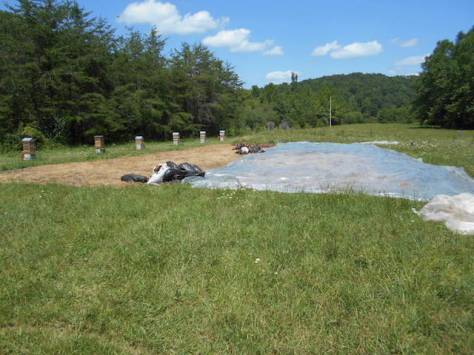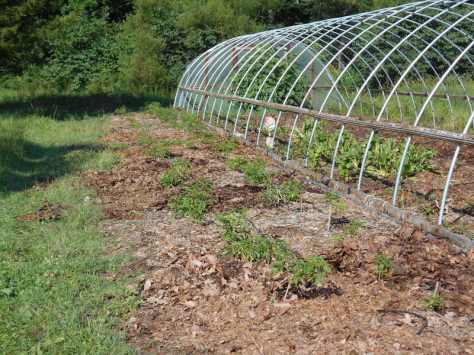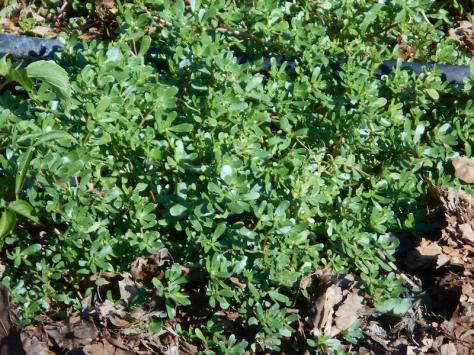One of the many, well millions, of projects on “the list” is to plant a bee meadow. That would be a meadow for bees–a place that provides nectar, pollen, and a safe place to hang out. I applied for a grant from USDA to convert one of the fields and a strip right through the middle of the apiary on the farm into pollinator habitat.
Didn’t get the grant. That doesn’t mean the bees can’t have what they were asking for. Using the 30×96 piece of plastic that came off the large high tunnel, I started smothering the weeds in the apiary itself. I put it about 10 feet from the hive fronts and left it in place for about 3-4 weeks. It did a great job of killing everything underneath. Yesterday I moved the plastic over and started mulching the dead area with leaves. I’d like to get the leaves on before it rains and before the seeds in there see daylight and start to come to life!
 As you can see in the photo, the beehives are along the left, the tan area is the dead plant material, and the plastic has been repositioned to smother another area 30×96.
As you can see in the photo, the beehives are along the left, the tan area is the dead plant material, and the plastic has been repositioned to smother another area 30×96.
My plans are to cover the entire area with a thick layer of leaves then run the mower over it to chop them up. Hopefully by the time I’m ready to seed (late fall) there will be a little protective layer of composting leaves on top to help the seeds germinate. So far, I’ve gotten a pound of a pollinator seed mix and other exuberant perennial seeds to plant here and there in the field as well. Several pots of bee balm, rudbeckia, mints, obedient plant, and lemon mint are going to be actually planted around the field as well because they love to spread and multiply and that’s exactly what I’m looking for in the meadow. Will keep you posted on the progress of this project.
Yesterday I took a bucket of leaves for mulching down to the elderberry patch. A few weeks ago I planted 65 elderberry bushes beside the large high tunnel so I could attach netting to the side of the tunnel to cover the bushes when they get berries on them. I want to make things with elderberries….jam, jelly, wine, syrup. To collect them from the wild you’ve got to race with the birds to get the ripe berries. I decided to just grow my own. Last winter I ordered cuttings (sticks) and rooted them in soil then grew them on up to planting size. Hopefully in a year or two there will be berries to pick.

While checking out the elderberries I spied a wonderful size patch of portulaca…….

I couldn’t really tell what it was when I first pulled up to the bed, and I dragged a bag of leaves over there to mulch whatever it was that was taking over that spot in the garden. Once I saw what it was, I weeded it, thanked it for being there, then continued to weed out all the different grasses that want to be in the same spot with the elderberries.
Portulaca is really good in a salad. It adds a nice crunch AND it’s bursting with Omega 3 acids–yep, yet another “weed” that’s awesomely healthy.
Another project that I’ve been busy with the last few days has been getting the high tunnels planted for winter crops. One of the hardest parts of my job is to get things started from seed, outside, this time of year.
Lettuce, spinach, kale, chard, arugula–all are synonymous with cool weather. The weather is not cool right now. The weather is miserable right now. So what’s a farmer to do? Try to fool Mother Nature-HA! I did use the Old Farmer’s Almanac to plant on the best days for planting, tried to get the soil in as good a shape as I could, then I planted. The seedbeds get watered twice a day if they need it and some of them have. I noticed this evening that the spinach is beginning to germinate in the smaller high tunnel. That’s always a relief!

One thing I’ve got to work on though–when I’m dragging the water hose through the center pathway it pushes leaves onto the seeds in the rows just adjacent to the center pathway–that’s not good! I’m thinking something hanging from the ceiling to slip the hose through so it’s suspended in the air rather than dragging around on the ground. Hey, another project for my list 🙂
